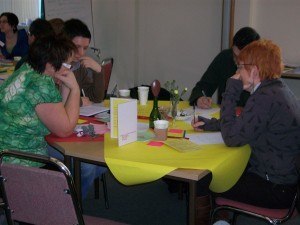Who Owns the Future by Jaron Lanier offers two visions for the future. Like all such visions, they are incomplete.
The first is a humanistic future, where machines help people become their true selves. It is where people find “the thing they cannot not do” and if they need help machines are on hand. So, the surgeon uses machines to monitor and guide her hand. And note this is a world where all benefit. Those who are differently-abled find machines help them live a full life. The key idea is shared benefits are true benefits. Maybe this is idealistic but some people have already chosen this future and through collective action we can choose to make this real for all.
The alternative is not, as you might expect, a machine-centred future. Machines have no purpose of their own and Artificial Intelligence is still something we’ll ever see. The alternative hierarchical future is where machines concentrate money and power into fewer hands. Again, some will argue, it is already happening.
Evidence for both futures can be seen in the present. We can choose either. There are other possible futures, for example where there are no machines because we can no longer fuel them. My hunch is the second future is a step along the road to ecological disaster.
Our Choice
We can choose to use machines to help us become better human beings. The key word in that last sentence is “us”. Who is “us”? I could have written, “We can choose to use machines to help others become better human beings”. Perhaps I mean “those whose hands are on the levers of power can choose to use machines for the benefit of others”. If current practice is evidence of their intentions in this respect, the prospects are not encouraging. The Volkswagen scandal suggests they have used machines to deceive; no-one believes they are the only ones.
“We can choose to use machines to help others become better human beings”. Look closely at the last sentence and ask, who is “we”? Perhaps the key to this is mutuality or self-interest. When I help others, I benefit too. The key to the future is not machines, it is collaboration. People working together for a better future for all.
Jaron Lanier
Jaron Lanier in his book “ Who Owns the Future?” argues the impact of machines has not been entirely benign because they have concentrated information into the hands of the few. Kodak used to employ 140 000 people and was worth $28 billion. It is now bankrupt and replaced by Instagram, worth $1 billion and employing 13 people.
Middle class people used to benefit from what Lanier calls levees. Levees are the walls built in fields to retain water and so feed the crops. It used to be possible to build levees around certain activities, where the practitioner’s expertise prevented others joining them without being accepted into the profession. Machines are used to break down these walls. For example, a few years ago you would have had to ask professional video makers to produce a video. Now you can easily do it yourself. Granted there is still a market for good videos from those who don’t have the time or patience to learn to do it well. The same applies to web design.
However, what might appear to be a process of democratisation, where people are able to do things they couldn’t a few years ago has its downside. Are those 13 Instagram employees really worth $76 million each? Compared with Kodak’s employees worth only $200K? If Instagram’s employees are really worth that much, I wonder how many of them have seen anything like $76 million.
Siren Servers
Lanier writes about “Siren Servers”; they
“gather data from the Internet, often without having to pay for it. The data is analysed using the most powerful available computers, run by the very best available technical people. The results of the analysis are kept secret, but are used to manipulate the rest of the world to advantage.”
Think of the impact of siren servers on bookshops. Siren servers practice data scraping, where they pick up bargains on rival bookshops’ websites and then they can undercut them. How do we react? We can choose to visit the local bookshop to look at books but there is always the temptation to find the online offer that undercuts their special offer. The net result is fewer bookshops. Is that what we really want?
(Yes I am a hypocrite. I use affiliate links to a huge siren server. I don’t do this for the money (income from my affiliation so far is zero) and I don’t believe this will significantly change. It serves as a link to more information about the book I’m reviewing. Where you choose to buy it is your choice. Perhaps we need a peoples’ movement who check out online and then purchase in shops, where shops are accessible.)
Conclusion
Lanier’s book is a good explanation of the challenges we face from those who control new technologies. He suggests solutions, which certainly open up new possibilities and show how decisions sharing data online are not set in stone.
Whether his solutions are practical is another matter. My view is people need to be realistic about where the power is online and work together to create genuine alternatives. These alternatives must be rooted in our lives as we live them and we decide if machines will aid us.
We have access to information and communication unparalleled in human history. We can allow the corporations to control it and so concentrate power in their hands or we can collaborate to build our own levees, where genuine interactions can take place in our neighbourhoods, cities, towns and villages.


